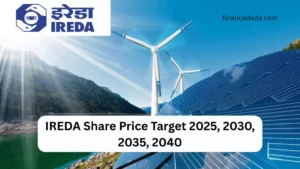NVIDIA Stock Price Target 2025, 2030, 2035, 2040 – A Comprehensive Forecast
NVIDIA Corporation (NASDAQ: NVDA) has solidified its position as a titan in the technology sector, driven by its dominance in artificial intelligence (AI), gaming, and data center solutions. With a market cap of $2.777 trillion as of May 2025, investors are keenly interested in NVIDIA’s stock price trajectory over the coming decades. This article explores NVIDIA stock price targets for 2025, 2030, 2035, and 2040, leveraging expert analysis, market trends, and long-term growth potential. While short-term forecasts rely on recent data, long-term projections are speculative and subject to macroeconomic and technological shifts.

NVIDIA Stock Price Target for 2025: Analyst Insights and Market Dynamics
As of May 13, 2025, NVIDIA’s stock closed at $113.82, reflecting a 0.59% decline from the previous day’s close of $114.50. Despite this dip, analysts remain optimistic about NVIDIA’s near-term growth. Piper Sandler, a prominent equity research firm, reiterated an “Overweight” rating with a 12-month price target of $150, suggesting a 31.8% upside. This target, though lower than their previous $175 estimate, accounts for potential headwinds from U.S. export restrictions on NVIDIA’s H20 AI chips, which could result in $5.5 billion in charges. The median price target, according to LSEG data, stands at $163.12, reinforcing bullish sentiment.
Monthly forecasts for 2025 paint a promising picture. Starting at $112 in May, projections suggest NVIDIA’s stock could climb to $145 by month-end, a 29.5% gain. By June, the price is expected to reach $167, driven by strong demand for NVIDIA’s AI chips and data center solutions. The year-end forecast for December 2025 is $163, representing a 45.5% increase from the May starting point. However, risks such as slowing capital spending or stricter export rules could cap gains, with Piper Sandler estimating a worst-case scenario of $76.25 if data center revenue drops by $9.8 billion annually.
Key Drivers for 2025:
- AI Leadership: NVIDIA’s GPUs remain critical for AI model training, with enterprises increasing IT budgets to adopt generative AI.
- Geopolitical Risks: Proposed U.S. legislation to track AI chips and potential tariffs could impact exports to China, a significant market.
- Market Sentiment: NVIDIA’s high beta (2.11) indicates volatility, but its 1-year return of 28.19% outperforms the S&P 500’s 10.57%.
| NVIDIA Stock Price Targets 2025 | Details |
|---|---|
| Current Price (May 13, 2025) | $113.82 |
| Piper Sandler Target | $150 (31.8% upside) |
| Median Target (LSEG) | $163.12 |
| Worst-Case Scenario | $76.25 |
| May 2025 Forecast | $145 (29.5% gain) |
| June 2025 Forecast | $167 |
| December 2025 Forecast | $163 (45.5% gain) |
NVIDIA Stock Price Target for 2030: Sustained Growth in AI and Beyond
Looking ahead to 2030, NVIDIA’s stock price trajectory depends on its ability to maintain dominance in AI, expand into new markets like automotive and robotics, and navigate regulatory challenges. Forecasts for 2029, the furthest detailed data available, project a June closing price of $981, a 776% increase from May 2025’s $112. Extrapolating to 2030, analysts expect NVIDIA to sustain double-digit growth, potentially reaching $1,100–$1,300 by mid-2030, assuming continued innovation and market expansion.
NVIDIA’s data center business, which drives the majority of its revenue, will likely remain a growth engine. The global AI market is projected to grow at a CAGR of 37.3% through 2030, per industry estimates, and NVIDIA’s CUDA platform positions it as the backbone of AI infrastructure. Additionally, CEO Jensen Huang’s strategic vision—highlighted by his Computex 2025 keynote on AI advancements—signals robust R&D investment. However, challenges like competition from AMD and Intel, coupled with potential oversupply in AI chips, could temper growth.
Factors Influencing 2030 Outlook:
- Diversification: NVIDIA’s push into autonomous vehicles and metaverse technologies could open new revenue streams.
- Global Demand: Recovery in China’s market and growth in emerging economies could boost sales.
- Valuation Concerns: With a current P/E ratio of 38.71, stretched valuations may invite corrections if earnings growth slows.
NVIDIA Stock Price Target for 2035: Long-Term Speculation
Projecting NVIDIA’s stock price for 2035 requires a broader lens, as technological and economic landscapes evolve significantly over a decade. Assuming NVIDIA maintains a 15–20% annualized growth rate—conservative relative to its 5-year return of 1,463.46%—the stock could reach $2,500–$3,500 by 2035. This range accounts for potential market cycles, including corrections, and NVIDIA’s ability to innovate in quantum computing, AI-driven healthcare, and sustainable energy solutions.
By 2035, NVIDIA’s role in shaping digital infrastructure could mirror that of today’s cloud giants. Its GPUs may power decentralized AI networks, smart cities, and advanced robotics. However, risks include regulatory scrutiny, as seen in proposed U.S. bills to monitor AI chip exports, and potential disruptions from emerging technologies like neuromorphic computing.
NVIDIA Stock Price Target for 2040: A Vision of Technological Dominance
By 2040, NVIDIA’s stock price could range from $6,000 to $10,000, reflecting a speculative but plausible scenario where the company remains a leader in transformative technologies. This projection assumes NVIDIA captures significant market share in AI, quantum computing, and human-machine interfaces, with global adoption of its platforms driving exponential revenue growth. A 2040 price target of $8,000 implies a market cap approaching $20 trillion, ambitious but feasible if NVIDIA sustains its current growth trajectory.
Risks to this outlook include geopolitical tensions, technological obsolescence, and economic downturns. Conversely, breakthroughs in AI ethics, energy-efficient chips, or space exploration could propel NVIDIA to new heights, especially if it partners with innovators like SpaceX, another xAI affiliate.
Risks and Considerations for Investors
While NVIDIA’s growth prospects are compelling, investors must weigh several risks:
- Volatility: NVIDIA’s high beta and sensitivity to market sentiment make it prone to sharp swings.
- Regulatory Headwinds: Export restrictions and antitrust scrutiny could limit growth in key markets.
- Competition: Rivals like AMD, Intel, and emerging startups may erode NVIDIA’s market share.
- Macroeconomic Factors: Inflation, interest rate hikes, or recessions could dampen IT spending.
| NVIDIA Historical Performance | NVIDIA | S&P 500 | Sector |
|---|---|---|---|
| 6-Month Return | -16.34% | -1.48% | -7.37% |
| 1-Year Return | 28.19% | 10.57% | 20.34% |
| 3-Year Return | 459.86% | 36.55% | 239.52% |
| 5-Year Return | 1,463.46% | 97.67% | 771.75% |
Long-Term Price Projections
| Year | Projected Price Range | Key Assumptions |
|---|---|---|
| 2030 | $1,100–$1,300 | Sustained AI dominance, market expansion |
| 2035 | $2,500–$3,500 | Innovation in quantum computing, healthcare |
| 2040 | $6,000–$10,000 | Leadership in AI, quantum, and human-machine interfaces |
Conclusion: Is NVIDIA a Buy for the Long Term?
NVIDIA’s stock offers a compelling blend of growth and risk. For 2025, analyst targets of $150–$163 suggest strong upside, driven by AI demand. By 2030, prices could approach $1,100–$1,300, with 2035 and 2040 targets of $2,500–$3,500 and $6,000–$10,000, respectively, reflecting NVIDIA’s potential to redefine technology. However, investors should remain vigilant about geopolitical, competitive, and economic risks.
Frequently Asked Questions (FAQs)
1. Is NVIDIA stock a good investment for 2025?
NVIDIA’s strong AI leadership and analyst targets of $150–$163 suggest significant upside for 2025. However, risks like export restrictions and market volatility require careful consideration.
2. What drives NVIDIA’s stock price growth?
NVIDIA’s growth is fueled by its dominance in AI, gaming, and data center markets, with increasing global demand for AI infrastructure and diversified ventures in automotive and robotics.
3. How reliable are long-term stock price forecasts for 2030 and beyond?
Long-term forecasts, like those for 2030, 2035, and 2040, are speculative and based on assumptions about market trends and innovation. They are not guarantees and should be used as a guide, not a certainty.
4. What are the biggest risks to NVIDIA’s stock price?
Key risks include geopolitical restrictions, competition from AMD and Intel, high valuations, and macroeconomic factors like inflation or reduced IT spending.
5. Should I consult a financial advisor before investing in NVIDIA?
Yes, consulting a certified financial advisor is crucial to assess your risk tolerance, portfolio goals, and the suitability of NVIDIA stock for your investment strategy.
6. How does NVIDIA’s performance compare to the broader market?
NVIDIA has significantly outperformed the S&P 500, with a 5-year return of 1,463.46% compared to the S&P 500’s 97.67%, though its high beta indicates greater volatility.
Disclaimer: The forecasts and opinions in this article are based on analyst reports and market trends, not guarantees of future performance. Investing in equities carries financial risks, and past performance does not predict future results. Consult a certified financial advisor before making investment decisions.
Also Read: RVNL Share Price Target 2025, 2027, 2030, 2035, 2040: A Comprehensive Long-Term Outlook









